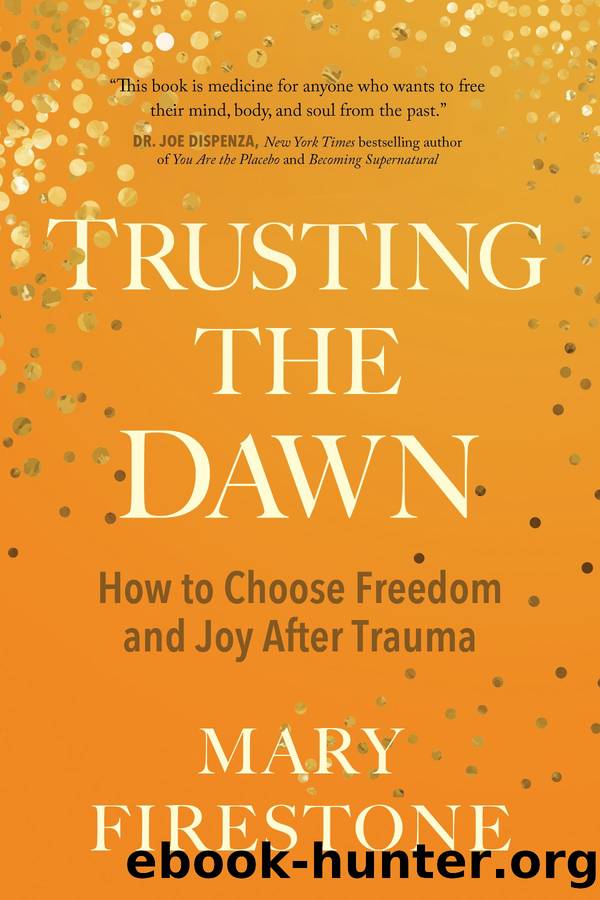Trusting the Dawn by Mary Firestone

Author:Mary Firestone [Firestone, Mary]
Language: eng
Format: epub
Tags: SEL043000 SELF-HELP / Post-Traumatic Stress Disorder (PTSD), SEL000000 SELF-HELP / General
Publisher: Sounds True
Craniosacral Therapy (CST)
Sarah Rebstock, craniosacral and massage therapist, offered me a complimentary session through a friend who had told her what I had recently been through. Her tiny therapy room in a yoga studio was dim and smelled like incense and patchouli. She was barefoot and not wearing any makeup, hair in braids, sweet, welcoming, and nurturing. It was a week or so after the mudslide, and it was such a relief and a comfort to lie there, receive, and relax that I actually fell into a restorative sleep, something that had been eluding me post-mudslide.
As with the EMDR, the session brought me instantaneous relief that endured for a while. It felt as though my brain went into a deeper state where healing actually occurs, free from the chatter of the thinking brain. The ârational/thinkingâ brain was quieted, and I was in a meditative dream state when I wasnât asleep. I felt like Rebstock helped my brain and my body let go of the gripping hypervigilance that can persist after a trauma. The amygdala, the part of the brain that senses threat, is on high alert following a trauma, and my amygdala needed to be told to relax and let go because I was no longer in danger.
The treatment itself consists of a full-body massage that ends with the practitioner sort of cradling your head. Pressing gently on parts of the neck and skull to induce relaxation and release, or as Rebstock explains it, âmeeting a person with what Iâve named âthe touch of observation.â At this point I am not trying to manipulate or change anything yet. I simply land, and ask, âWhat is the tissue doing/trying to show me; what is the most acute thing Iâm noticing; what is the most subtle/almost imperceptible thing?ââ
She explains that she silently introduces herself to the inner healer of the client, offering her service, stating her boundaries, and inviting that part of the client to show her what it needs. The Upledger Institute, founded by John Upledger, one of the worldâs foremost craniosacral experts, calls this initial phase blending and melding. With trauma, this phase usually takes longer, Rebstock explains, not because it is harder to discern what is going on in the body but to build trust, gently allow the clientâs central nervous system to regulate to your presence and touch, and let the tissue invite you in at its own pace. Being patient here is key. Force nothing. Rebstock emphasizes that the practitioner being invited is necessary. This recognizes and honors the bodily autonomy of the client, and for a traumatized body this is even more important.
Rebstock sheds light on what she experiences in working with the client:
Download
This site does not store any files on its server. We only index and link to content provided by other sites. Please contact the content providers to delete copyright contents if any and email us, we'll remove relevant links or contents immediately.
Rewire Your Anxious Brain by Catherine M. Pittman(18531)
Talking to Strangers by Malcolm Gladwell(13185)
The Art of Thinking Clearly by Rolf Dobelli(10175)
Mindhunter: Inside the FBI's Elite Serial Crime Unit by John E. Douglas & Mark Olshaker(9160)
Becoming Supernatural by Dr. Joe Dispenza(8090)
Change Your Questions, Change Your Life by Marilee Adams(7610)
Nudge - Improving Decisions about Health, Wealth, and Happiness by Thaler Sunstein(7544)
The Road Less Traveled by M. Scott Peck(7501)
The Lost Art of Listening by Michael P. Nichols(7388)
Mastermind: How to Think Like Sherlock Holmes by Maria Konnikova(7195)
Enlightenment Now: The Case for Reason, Science, Humanism, and Progress by Steven Pinker(7163)
Win Bigly by Scott Adams(7078)
The Way of Zen by Alan W. Watts(6480)
Daring Greatly by Brene Brown(6428)
Big Magic: Creative Living Beyond Fear by Elizabeth Gilbert(5575)
Grit by Angela Duckworth(5492)
Ego Is the Enemy by Ryan Holiday(5266)
Men In Love by Nancy Friday(5138)
Altered Sensations by David Pantalony(5030)
